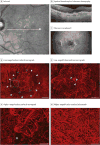Histopathological Insights Into Choroidal Vascular Loss in Clinically Documented Cases of Age-Related Macular Degeneration
- PMID: 27657855
- PMCID: PMC6014730
- DOI: 10.1001/jamaophthalmol.2016.3519
Histopathological Insights Into Choroidal Vascular Loss in Clinically Documented Cases of Age-Related Macular Degeneration
Abstract
Importance: Age-related macular degeneration (AMD) is a multifactorial disease with genetic and environmental factors contributing to risk. Histopathologic changes underlying AMD are not fully understood, particularly the relationship between choriocapillaris (CC) dysfunction and phenotypic variability of this disease.
Objective: To examine histopathologic changes in the CC of eyes with clinically documented AMD.
Design, setting, and participants: The study was designed in 2011. Tissues were collected post mortem (2012-2016), and histopathological images were obtained from participants enrolled in AMD studies since 1988. Clinical records and images were collected from participants as standard protocol. Eyes without AMD (n = 4) and eyes with early (n = 9), intermediate (n = 5), and advanced stages of AMD (geographic atrophy, n = 5; neovascular disease, n = 13) were evaluated. Choroidal vasculature was labeled using Ulex europaeus agglutinin lectin and examined using confocal microscopy.
Main outcomes and measures: A standardized classification system was applied to determine AMD stage. Ocular records and images were reviewed and histopathologic analyses performed. Viability of the choroidal vasculature was analyzed for each AMD stage.
Results: All participants were white. Fourteen were male, and 16 were female. The mean age was 90.5 years among AMD patients and 88.5 years among control participants. Submacular CC dropout without retinal pigment eipthelial (RPE) loss was observed in all cases with early stages of AMD. Higher vascular area loss for each AMD stage was observed compared with control participants: 20.5% in early AMD (95% CI, 11.2%-40.2%; P < .001), 12.5% in intermediate AMD (95% CI, 2.9%-21.4%; P = .01), 39.0% loss in GA (95% CI, 32.1%-45.4%; P < .001), and 38.2% loss in neovascular disease where RPE remained intact (95% CI, 27.7%-47.9%; P < .001). Hypercellular, apparent neovascular buds were adjacent to areas of CC loss in 22.2% of eyes with early AMD and 40% of eyes with intermediate AMD.
Conclusions and relevance: Retinal pigment epithelial atrophy preceded CC loss in geographic atrophy, but CC loss occurred in the absence of RPE atrophy in 2 of 9 eyes with early-stage AMD. Given the cross-sectional nature of this study and the small number of eyes evaluated, definitive conclusions regarding this progression cannot be determined with certainty. We speculate that neovascular buds may be a precursor to neovascular disease. Hypoxic RPE resulting from reduced blood supply might upregulate production of vascular endothelial growth factor, providing the stimulus for neovascular disease.
Conflict of interest statement
Figures





Comment in
-
Early Insight Into Neovascular Age-Related Macular Degeneration.JAMA Ophthalmol. 2016 Nov 1;134(11):1281-1282. doi: 10.1001/jamaophthalmol.2016.3031. JAMA Ophthalmol. 2016. PMID: 27657333 No abstract available.
References
-
- Friedman DS, O’Colmain BJ, Muñoz B, et al. Eye Diseases Prevalence Research Group Prevalence of age-related macular degeneration in the United States. Arch Ophthalmol. 2004;122(4):564–572. - PubMed
-
- Lim LS, Mitchell P, Seddon JM, Holz FG, Wong TY. Age-related macular degeneration. Lancet. 2012;379(9827):1728–1738. - PubMed
-
- McLeod DS, Taomoto M, Otsuji T, Green WR, Sunness JS, Lutty GA. Quantifying changes in RPE and choroidal vasculature in eyes with age-related macular degeneration. Invest Ophthalmol Vis Sci. 2002;43(6):1986–1993. - PubMed
MeSH terms
Grants and funding
LinkOut - more resources
Full Text Sources
Other Literature Sources
Medical
Molecular Biology Databases

